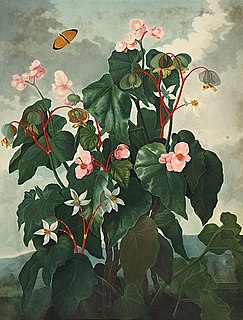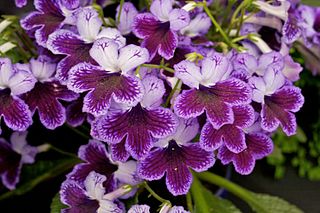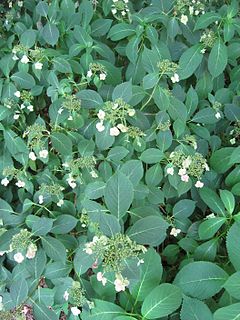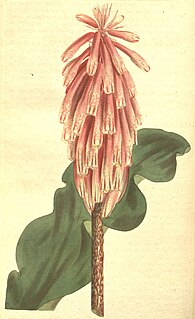
Begonia is a genus of perennial flowering plants in the family Begoniaceae. The genus contains more than 1,800 different plant species. The Begonias are native to moist subtropical and tropical climates. Some species are commonly grown indoors as ornamental houseplants in cooler climates. In cooler climates some species are cultivated outside in summertime for their bright colourful flowers, which have sepals but no petals.

Alstroemeria, commonly called the Peruvian lily or lily of the Incas, is a genus of flowering plants in the family Alstroemeriaceae. They are all native to South America although some have become naturalized in the United States, Mexico, Australia, New Zealand, Madeira and the Canary Islands. Almost all of the species are restricted to one of two distinct centers of diversity, one in central Chile, the other in eastern Brazil. Species of Alstroemeria from Chile are winter-growing plants while those of Brazil are summer-growing. All are long-lived perennials except A. graminea, a diminutive annual from the Atacama Desert of Chile.

Hibiscus syriacus is a species of flowering plant in the mallow family, Malvaceae. It is native to south-central and southeast China, but widely introduced elsewhere, including much of Asia. It was given the epithet syriacus because it had been collected from gardens in Syria. Common names include the Korean rose, rose of Sharon, Syrian ketmia, shrub althea, rose mallow. It is the national flower of South Korea and is mentioned in the South Korean national anthem.

Lathyrus latifolius, the perennial peavine, perennial pea, broad-leaved everlasting-pea, or just everlasting pea, is a robust, sprawling perennial in the Pea Family Fabaceae. It is native to Europe but is present on other continents, such as North America and Australia, where it is most often seen along roadsides.

Crocosmia (montbretia) is a small genus of flowering plants in the iris family, Iridaceae. It is native to the grasslands of southern and eastern Africa, ranging from South Africa to Sudan. One species is endemic to Madagascar.

Cortaderia selloana, commonly known as pampas grass, is a flowering plant native to southern South America, including the Pampas region after which it is named.

Lobularia maritima syn. Alyssum maritimum, common name sweet alyssum or sweet alison, also commonly referred to as just alyssum is a species of low-growing flowering plant in the family Brassicaceae.

A popular house plant, Streptocarpus, is an Afrotropical genus of flowering plants in the family Gesneriaceae. The genus is native to Afromontane biotopes from central, eastern and southern Africa, including Madagascar and the Comoro Islands. The flowers are five-petalled, salverform tubes, almost orchid-like in appearance, and hover or arch over the plant. In the wild, species can be found growing on shaded rocky hillsides or cliffs, on the ground, in rock crevices, and almost anywhere the seed can germinate and grow. For the home, there are now many hybrids of various colours and forms available.

Anaphalis is a genus of herbaceous and woody flowering plants within the family Asteraceae, whose members are commonly known by the name pearl or pearly everlasting. There are around 110 species with the vast majority being native to central and southern Asia. There is one species native to North America that is fairly well known and popular in cultivation, namely the western pearly everlasting.

Lavandula angustifolia, formerly L. officinalis, is a flowering plant in the family Lamiaceae, native to the Mediterranean.

Aurinia saxatilis is an ornamental plant native to Asia and Europe.

Anaphalis margaritacea, commonly known as the western pearly everlasting or pearly everlasting, is an Asian and North American species of flowering perennial plant in the sunflower family. It is widespread across most of the United States and Canada, as well as northwestern Mexico. Asian populations are found in China, the Russian Far East, Japan, Korea, northern Indochina, and the Himalayas. The species is reportedly naturalized in Europe though not native there.

Aster amellus, the European Michaelmas-daisy, is a perennial herbaceous plant in the genus Aster of the family Asteraceae. In the language of flowers, the Michaelmas-daisy symbolizes a farewell or a departure.

Campanula poscharskyana, the Serbian bellflower or trailing bellflower, is a semi-evergreen trailing perennial, valued for its lavender-blue star-shaped flowers, native to the Dinaric Alps in former Yugoslavia.

Hydrangea serrata is a species of flowering plant in the family Hydrangeaceae, native to mountainous regions of Korea and Japan. Common names include mountain hydrangea and tea of heaven. Growing to 1.2 m (4 ft) tall and broad, it is a deciduous shrub with oval leaves and panicles of blue and pink flowers in summer and autumn (fall). It is widely cultivated as an attractive ornamental shrub throughout the world in areas with suitable climate and soil.

Anemone blanda, common names Balkan anemone, Grecian windflower or winter windflower, is a species of flowering plant in the family Ranunculaceae, native to southeastern Europe, Turkey, Lebanon, and Syria. The specific epithet blanda means "mild" or "charming". The genus name is derived from the Greek word anemos, or wind.

Cyclamen persicum, the Persian cyclamen, is a species of flowering herbaceous perennial plant growing from a tuber, native to rocky hillsides, shrubland, and woodland up to 1,200 m (3,900 ft) above sea level, from south-central Turkey to Lebanon-Syria, east to Jordan and south to Israel and the west bank. It also grows in Algeria and Tunisia and on the Greek islands of Rhodes, Karpathos, and Crete, where it may have been introduced by monks. Cultivars of this species are the commonly seen florist's cyclamen.

Colchicum speciosum is a species of flowering plant in the family Colchicaceae, native to mountainous areas of northern Turkey, the Caucasus and northern Iran. Growing to 18 cm (7 in) tall by 10 cm (4 in) wide, it is an herbaceous perennial growing from corms. C. speciosum blooms in the fall, producing reddish/violet flowers on stems up to 30 centimetres (12 in) tall without any leaves present. The strap-like leaves grow in the spring, then yellow, wither and die back as summer progresses. The flowers strongly resemble those of the crocus, the familiar spring-flowering bulb; hence the common name autumn crocus which is applied to this and other colchicum species. However the two genera belong to different families; and there is in fact an autumn-flowering crocus species, Crocus sativus, the source of the spice saffron. By contrast, all parts of Colchicum speciosum are toxic if ingested.

Veltheimia capensis is one of two species of flowering plants belonging to the genus Veltheimia, of the family Asparagaceae. It is a tender bulbous perennial reaching a height of 46 cm (18 in), with flowers varying in color from white with red spots to pink with green or red markings.

Iris series Spuriae are a series of the genus Iris, in Iris subg. Limniris. They are sometimes commonly known as butterfly irises.




















